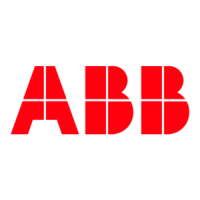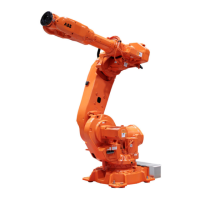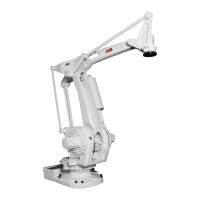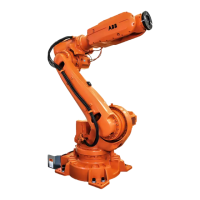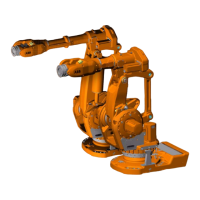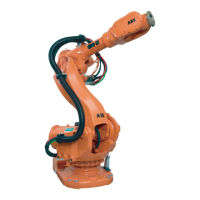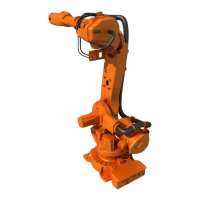
 Loading...
Loading...
Do you have a question about the ABB IRB 6640 and is the answer not in the manual?
Introduces safety information categories, general and specific safety aspects, and ways to avoid injuries and product damage.
Covers general safety aspects, validity, responsibility, external safety devices, and limitations of liability for manipulator systems.
Details safety signals, symbols on manipulator labels, and specific safety instructions for DANGER, WARNING, and CAUTION scenarios.
Provides information on installing the robot at the working site, including load diagrams, permitted extra loads, and safety prerequisites.
Highlights design differences between IRB 6640 Design 1 and Design 2, specifically regarding the lower arm features.
Details ABB-approved transportation precautions for ABB robots, including methods 1 and 2 to prevent damage.
Describes how to securely mount the robot using the transport support, emphasizing safety during brake release.
Covers pre-installation procedures, checks for installation readiness, robot weights, storage, operating conditions, and protection classes.
Provides instructions for lifting the robot with fork lift, roundslings, manually releasing brakes, and securing the base plate.
Explains how to restrict the working range of axes 1, 2, and 3 using mechanical stops and software adjustments.
Details robot cabling and connection points, categorizing main cable types and sub-categories for power and signals.
Provides additional installation procedures for Foundry Prime robots, covering environmental conditions and air specifications for pressurizing.
Outlines additional installation procedures for Cleanroom robots, focusing on particle emission control and cleaning preparations.
Introduces the maintenance chapter, detailing activities based on a schedule and referring to specific procedures for tasks.
Specifies maintenance intervals and expected component lifetimes, including calendar time, operating time, and SIS data.
Lists inspection procedures for oil levels in gearboxes (axes 1-6), balancing devices, cable harnesses, information labels, dampers, and mechanical stops.
Covers procedures for changing gearbox oil (axes 1-6), replacing SMB batteries, and general replacement activities.
Details lubrication procedures for spherical roller bearings and rust preventive measures for sealing and support bearings.
Provides instructions for cleaning the robot based on its protection class (Standard, Foundry Plus, Foundry Prime, Clean Room).
Introduces the repair chapter, detailing activities for the robot and external units, including spare parts and tools.
Covers general repair procedures such as leak-down tests, mounting instructions for bearings, seals, and exchange of parts on Clean room robots.
Details replacement procedures for major robot components like cable harnesses and the complete arm system.
Covers replacement of components within the upper and lower arm assemblies, including turning disks, wrist units, and upper/lower arms.
Provides procedures for replacing SMB units, brake release units, and spherical roller bearings in the balancing device.
Details replacement procedures for motors on axes 1, 2, 3, 4, 5, and 6 of the robot.
Covers replacement procedures for gearboxes on axes 1, 2, 3, and 6 of the robot.
Introduces calibration information, covering methods and procedures not requiring specific equipment.
Specifies calibration types (Standard, Absolute Accuracy) and methods (Calibration Pendulum, CalibWare) for robot positioning.
Illustrates calibration scales and marks on the robot for ensuring correct axis positions during calibration.
Details the correct movement directions for robot axes during calibration to ensure consistent positioning and avoid backlash issues.
Explains how to update revolution counter values, crucial after battery replacement or system reconfigurations.
Describes methods to check the robot's calibration position using MoveAbsJ instructions or the Jogging window.
Introduces decommissioning procedures for taking products, robots, or controllers out of operation.
Provides information on hazardous materials in robots and proper disposal of oil, grease, and components according to regulations.
Details a special procedure for dismantling the balancing device due to stored energy, requiring professional handling.
Introduces the reference information chapter, complementing specific procedures with general information.
Lists applicable safety standards (EN ISO, European, Other) relevant to robot design and operation.
Provides a converter table for units used in the manual, facilitating conversions between metric and imperial systems.
Details how to tighten various screw joints on the robot, including UNBRAKO screws, Gleitmo treated screws, and Molycote lubricated screws.
Specifies weights of components handled during installation, repair, and maintenance, highlighting those exceeding 22 kg.
Lists standard tools required for service, repairs, and installation procedures, forming a base toolkit.
Lists special tools required for specific service procedures, including those for motor and gearbox work.
Details the configuration and use of the dismounting and mounting tool for balancing devices and shafts.
Explains that lifting equipment requirements are specified per procedure and refers to separate instructions for use.
States that circuit diagrams are not included in the manual but are available as separate documents on the DVD with article numbers provided.
